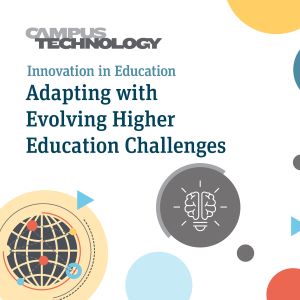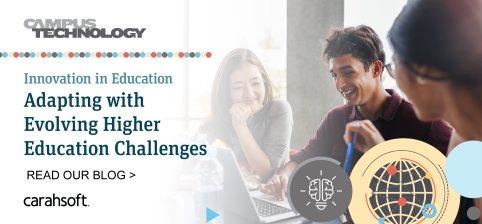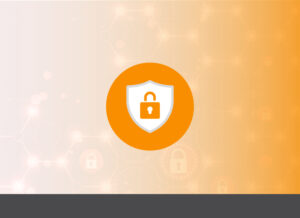For many colleges and universities, the global pandemic served as a wake-up call for more innovative teaching models. They quickly discovered that remote learning is no longer an occasional tool for specific situations. Instead, a mix of in-person and online platforms has become an imperative to ensure digital equity and educational excellence. Even before the pandemic, researchers cited the importance of course design and the need for a pedagogical shift to ensure success in blended learning. Now, many believe that as faculty and students become more proficient with the technology and adapt to online education, outcomes will improve. Close collaboration between faculty and technology teams is also important as both groups adapt to new teaching models. To ensure clear communication, many institutions will need to invest in cameras, microphones and speaker systems, and many classes may benefit from a technology assistant who keeps track of the messages students post and resolves any technical issues. Incorporating such modern tools alongside institutions’ legacy solutions presents a diverse set of challenges. In the Campus Technology survey, staying within budget constraints (44%) was the top challenge cited by respondents, and it goes hand in hand with choosing the right products, services and solutions (41%). Technological challenges also include getting legacy and modern solutions to work together (36%), sharing data between legacy and modern systems (27%), and managing and securing a diverse IT ecosystem (25%). Learn how, by investing in further modernization, your institution can boost its ability to meet current demands while maintaining flexibility to respond to the unknown challenges ahead in Carahsoft’s Innovation in Education report.
Embracing the New Normal in Higher Education
“By allowing students of different backgrounds, perspectives, and ages to interact with one another, a hybrid or HyFlex approach enriches the classroom experience. That flexibility should be used as a recruitment tool: By offering a range of options for in-person and online learning, institutions can dramatically expand their reach nationally and even internationally. The success of the new normal in education hinges on being able to measure student engagement. In a face-to-face classroom, instructors can note whether students are making eye contact and how many of them are raising their hands or asking questions. At Class Technologies, we enable instructors to bring that same emphasis on student outcomes into an online format.”
Read more insights from Class Technology’s Senior Director of Advocacy and Community, Dr. Kim Oppelt.
Using Data Analytics to Enhance Student Services
“In addition to automation, artificial intelligence can transform the way colleges and universities provide services to their students. When higher education leaders understand the value and availability of AI, they can create a vision for its adoption. Then data analysts can use AI to accelerate the institution’s delivery of student services and improve its ability to predict outcomes early, enabling educators to address trouble spots early or invest in key initiatives. With AI, analysts can focus at the level of the entire student population, a certain demographic profile or the individual student. For example, AI can integrate with a campus learning system to identify students who may be at risk of dropping out. To be successful, AI must be part of an institution’s overall data management strategy, and the IT infrastructure should be built or updated to support that strategy.”
Read more insights from Cloudera’s Senior Solutions Engineer, Brian Hagan.
A Cybersecurity Mesh Speeds Digital Transformation
“Research firm Gartner defines a cybersecurity mesh as a “flexible, composable architecture that integrates widely distributed and disparate security services” — in other words, it enables institutions to leverage a suite of complementary tools. A mesh architecture creates efficiency and greater coverage across the digital surface, while enabling the IT team to understand what’s happening on its network and better prepare for the next cybersecurity event. This concept can also reduce the number of point security solutions and products. To make the business case for taking that approach, focus on demonstrating return on investment. A mesh architecture reduces costs because it consolidates tools and services while simplifying digital transitions. The mesh components will enable standardized training and raise the bar on knowledge transfer across the distributed IT environment.”
Read more insights from Fortinet’s Field CISO for Education, Bob Turner.
Why Student Experience Equals Student Success
 “Student needs are so individualized that a single, one-size-fits-all approach to services is ineffective. Institutions need systems that can constantly learn from students as they’re navigating their experience on campus and then take student-specific action. Qualtrics’ experience management platform enables students to share feedback in a host of different ways and then crucially, pairs that data with internal systems to help institutions gain a holistic view of those students. Campus leaders can listen, understand and act through a platform that gathers information and converts it into real-time insights for decision-makers. In addition, the Qualtrics platform uses artificial intelligence to help schools understand what friction points exist in the student journey and then helps to automate actions, such as connecting students with the right resources, at scale. By giving the right people the right information at the right time, AI enables institutions to intervene at the moments that matter most. It also helps decision-makers measure the impact of those actions.”
“Student needs are so individualized that a single, one-size-fits-all approach to services is ineffective. Institutions need systems that can constantly learn from students as they’re navigating their experience on campus and then take student-specific action. Qualtrics’ experience management platform enables students to share feedback in a host of different ways and then crucially, pairs that data with internal systems to help institutions gain a holistic view of those students. Campus leaders can listen, understand and act through a platform that gathers information and converts it into real-time insights for decision-makers. In addition, the Qualtrics platform uses artificial intelligence to help schools understand what friction points exist in the student journey and then helps to automate actions, such as connecting students with the right resources, at scale. By giving the right people the right information at the right time, AI enables institutions to intervene at the moments that matter most. It also helps decision-makers measure the impact of those actions.”
Read more insights from Qualtrics’ Vice President Higher Education Strategy, Joshua Sine.
Pivoting to Continuous Modernization in Higher Education
“Continuous modernization involves making small changes and regularly deploying those changes under a methodology called continuous integration/continuous deployment (CI/CD). Users try out new features, and developers get immediate validation and testing throughout the entire process, which results in targeted and ongoing improvements. Another key element is automation. When rote tasks such as spinning up virtual machines, configuring networks or resolving users’ help tickets are automated, IT administrators can focus on more complex activities, such as improving processes or incorporating new technologies. In addition, containerization makes it easy to migrate applications and workloads back and forth from on-premises systems to the cloud as needed.”
Read more insights from Red Hat’s Chief Architect for Education and the North America Public Sector, Damien Eversmann.
Using the Power of Data to Support Collaboration
“Data analysis can help institutions gain a fuller understanding of their cybersecurity posture. For example, it can enable risk-based alerting, so staffers are not overwhelmed with security alerts that aren’t important. In addition, many institutions are merging their development, security and operations cycles in a methodology called DevSecOps. That collaborative approach ensures that security is an integral element of IT systems rather than an afterthought. Collaboration also results in deeper insights. When institutions can access and analyze student experience and outcomes, they have a much clearer picture of what they need to do from a strategy and planning perspective to enhance academic programs and student services.”
Read more insights from Splunk’s Strategic Advisor, Frank Myers, and Business Development Manager, Elizabeth Thompson.
A Data-Informed Approach to Recruiting and Retaining Faculty
“UT Austin has a strong commitment to nominating faculty for major awards across racial and gender lines. However, we wanted to pinpoint any gaps in the nomination process to make sure we retain talented faculty members by recognizing a diversity of research. We chose to partner with Tableau because the company offers a user-friendly process for developing self-service dashboards. In this case, an awards analysis dashboard helps us quickly identify under-awarded faculty in each department and drill down into race/ethnicity and gender information. As a result, we have achieved better equity in the awards nomination process and improved our faculty recruitment and retention efforts.”
Read more insights from the University of Texas at Austin’s Chief Data Officer and Executive Director of Institutional Reporting, Research and Information Systems, Shiva Jaganathan.
Creating a Single Source of Data Truth
“The ability to make those kinds of informed decisions hinges on robust data sharing. Unfortunately, many institutions still lack consistency in data access and management. And when data exists in silos, there is no single source of truth. Breaking down silos to give end users the power to do their own research is crucial, and that culture change starts at the top. Leaders must drive the demand for universal access to data so that everyone can be confident in the data they’re using and the decisions they’re making. At Tableau, our mission is to help people see and understand data. We continually enhance our product to ensure that decision-makers at all levels have access to the data and insights they need.”
Read more insights from Tableau’s Regional Vice President of Education and Nonprofit Sales, Cassidy Macias, and Vice President of U.S. Education Enterprise Sales, Adam Ingram-Eiser.
Discovering the Endless Possibilities of Automation
“From recruitment through graduation and beyond, automation can play a crucial role in ensuring that students have the experience the college or university wants them to have. Automation can help students succeed, and after they graduate, automation can be used to stay in touch — for example, by congratulating them on a new job when their LinkedIn profile changes and encouraging them to give back to the university. In the past couple of years, a mental health crisis has arisen in higher education, and many students withdrew from institutions or struggled to keep up with their studies. Tackling the issue should be a top priority in higher education because the crisis will continue for at least a few more years as people become accustomed to going back to campuses and in-person learning. Automated services can help institutions check in with students to see how they’re doing and connect them with mental health resources if necessary.”
Read more insights from UiPath’s Global State, Local and Regional Government Industry Lead, Dan Horan.
A More Immersive Experience for Students and Staff
“Zoom was a market leader in higher education even before the pandemic because our tools are affordable and easy to use. We have built a unified communications platform on top of our popular videoconferencing technology and, for the past two years, have focused on creating a superior on-campus experience by integrating communication across all operating systems and expanding capabilities via cloud telephony with Zoom Phone. For example, among many amazing features, using the Zoom application on a smartphone gives users the ability to have Zoom Phone voicemail messages transcribed and sent to their e-mail. In addition, while most people are familiar with the chat function that’s enabled during a Zoom meeting, we have a separate, robust Zoom Chat collaboration tool built into our unified communications stack. It allows users to create communication channels for particular projects or teams and conduct one-on-one or group chats.”
Read more insights from Zoom’s Global Education Marketing Lead, Johann Zimmern.
Download the full Innovation in Education report for more insights from these IT modernization thought leaders and for additional industry research from Campus Technology.








